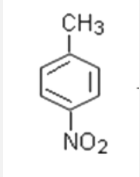The product in the following reaction is:
Ph−Cl+Fe/Br2→ Product
o-bromo-chloro benzene
p-bromo-chloro benzene
A and B both
2,4,6-tribromo chloro benzene
The correct Answer is:C
To determine the product of the reaction between chlorobenzene (Ph-Cl) and bromine (Br2) in the presence of iron (Fe), we can follow these steps:
Step 1: Identify the Reactants
The reactants in this reaction are:
- Chlorobenzene (Ph-Cl)
- Bromine (Br2)
- Iron (Fe) as a catalyst
Step 2: Understand the Reaction Type
This reaction is an electrophilic aromatic substitution. In this type of reaction, the bromine (Br2) will substitute for the chlorine (Cl) on the benzene ring of chlorobenzene.
Step 3: Analyze the Reactivity
Bromine (Br2) is a strong electrophile, especially in the presence of iron, which can help generate bromine radicals or bromonium ions that can react with the aromatic ring.
Step 4: Determine the Substitution Positions
Chlorobenzene has a chlorine atom attached to the benzene ring. The presence of the chlorine atom is a deactivating group but also ortho/para directing. This means that bromine will preferentially substitute at the ortho (2-position) and para (4-position) positions relative to the chlorine atom.
Step 5: Predict the Product
Since bromine can substitute at multiple positions, we can expect multiple bromine atoms to be added to the benzene ring. The most likely product will be:
- Bromine substituting at the 2, 4, and 6 positions of the benzene ring.
Thus, the product will be:
- 2,4,6-tribromochlorobenzene
Step 6: Write the Final Product
The final product of the reaction is:
- 2,4,6-tribromochlorobenzene
Summary
The product of the reaction between chlorobenzene and bromine in the presence of iron is 2,4,6-tribromochlorobenzene.
---
The reactants in this reaction are:
- Chlorobenzene (Ph-Cl)
- Bromine (Br2)
- Iron (Fe) as a catalyst
This reaction is an electrophilic aromatic substitution. In this type of reaction, the bromine (Br2) will substitute for the chlorine (Cl) on the benzene ring of chlorobenzene.
Bromine (Br2) is a strong electrophile, especially in the presence of iron, which can help generate bromine radicals or bromonium ions that can react with the aromatic ring.
Chlorobenzene has a chlorine atom attached to the benzene ring. The presence of the chlorine atom is a deactivating group but also ortho/para directing. This means that bromine will preferentially substitute at the ortho (2-position) and para (4-position) positions relative to the chlorine atom.
Since bromine can substitute at multiple positions, we can expect multiple bromine atoms to be added to the benzene ring. The most likely product will be:
- Bromine substituting at the 2, 4, and 6 positions of the benzene ring.
- 2,4,6-tribromochlorobenzene
The final product of the reaction is:
- 2,4,6-tribromochlorobenzene
The product of the reaction between chlorobenzene and bromine in the presence of iron is 2,4,6-tribromochlorobenzene.
Topper's Solved these Questions
- ELECTROCHEMISTRYBook:ALLENChapter:ELECTROCHEMISTRYExercise:MISCELLANEOUS SOLVED EXAMPLES
Explore 29 Videos
- ELECTROCHEMISTRYBook:ALLENChapter:ELECTROCHEMISTRYExercise:COMPREHENSION TYPE
Explore 18 Videos
- CHEMISTRY AT A GLANCEBook:ALLENChapter:CHEMISTRY AT A GLANCEExercise:ORGANIC CHEMISTRY
Explore 472 Videos
- HYDROCARBONBook:ALLENChapter:HYDROCARBONExercise:MCQ
Explore 15 Videos
Similar Questions
Knowledge Check
Identify the product of the following reaction.
ClCH2CH2CH2Br+KCN→productAClCH2CH2CH2CNBCNCH2CH2BrCCNCH2CH2CH2CNDClC∣CNHCH2CH2Br
The final product in the reaction is :
Ph−OH+CCl4KOH−−→ product
View SolutionWrite the product of the following reaction :
(i) CH3−Cl+KCN→?
(ii)
View SolutionPredict product(s) in the following reaction,
Cl2+OH−hot−−→?
View SolutionIdentify the product (E) in the following sequence of reactions.
 Br2−−→ASn/HCl−−−−→BNaNO2/HCl−−−−−−−−−−→273−278KCH2O/H3PO2−−−−−−−→DKMnO4−−−−−−−→OH−E
Br2−−→ASn/HCl−−−−→BNaNO2/HCl−−−−−−−−−−→273−278KCH2O/H3PO2−−−−−−−→DKMnO4−−−−−−−→OH−E
View SolutionConsider the following reaction CH3−CH=CH2Br2/NaCl−−−−−−→ Product of the reaction will be
View SolutionThe end product (B) in the following sequence of reactions is CH3ClKCN−−→AH2O/H+−−−−−→B
View SolutionThe major product of the following reaction is :
CH3CH2CH−CH2 | | Br Br I. KOH alc−−−−−−→II.NaNH2in liqNH3
View Solution